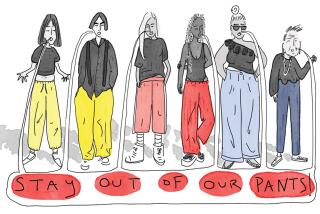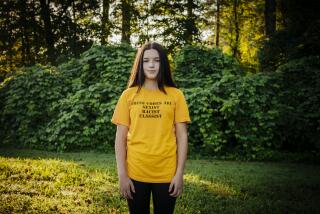The Rule With Pants: If Shoe Fits, Wear It
Dear Fashion Police: I am a retired lady of a certain age, still fairly trim and groomed, and I would like advice on when to wear flat shoes or heels with pants. I wear jean-style pants of varying fabrics, most of the time with flats. Sometimes I feel like getting a little dressier, in shoes with a bit of heel. What are the rules for wearing either flats or heels with pants?
--FILL ME IN
Dear Fill: Open a fashion magazine and you’ll see that any semblance of rules about wearing pants with flats or heels is gone. Low-slung jeans are worn with patent leather high-heeled mules, cuffed wool trousers with high strappy sandals and leather pants with pointy-toe flats.
Since you are “of a certain age,” we don’t know how funky you like to get when it comes to your wardrobe, so we’ll err on the side of conservatism and give you a few general guidelines.
Your shoes and pants should have the same level of casualness or formality, whether they’re heels or flats. Since you asked about heels, here are some possibilities: Pair jeans or jean-style pants with distressed leather mid-heel boots, lace-up vintage boots with a 2-inch pointy heel, or Western-style suede boots. Also try them with some retro ‘50s sling-backs with a small heel, some bow-front shoes with a chunky heel, or some mid-heel loafers. Stay away from things like square-toe leather pumps, which scream “office.”
Getting more formal, tailored pinstripe trousers go with sleek black leather ankle boots, basic pumps or sling-backs in mid to high heels. Nix sneakers or ultra-rugged boots. And for evening, consider black velvet pants with strappy sandals (gold or black), stiletto heel pumps with a rhinestone heel or boots again--low, black patent, thin heel.
Die-hard high-heel-wearers should remember to occasionally alternate them with flats. Your feet, Achilles’ heel, ankles and legs will thank you.
From the Fashion Police Blotter: Last week “Wants It Back the Way It Was” wrote to us asking our opinion about her law firm’s new dress code, which outlawed open-toe shoes and jeans. “Wants” argued that dressing down is perfectly acceptable on days when she doesn’t have to be in court and for the company’s office-bound clerical staff. Jeans, she argued, are “a morale-builder if allowed on Fridays.”
We respectfully disagreed, saying that a professional office that entertains clients should look professional, meaning no jeans or open-toe shoes. There are plenty of dressier alternatives--still comfortable--which project a better image. We also theorized that when the economy sags, companies begin to issue stricter dress codes. It’s a 180 from when the economy was fat and happy and companies desperate for employees often lured them with perks such as casual dress codes.
Now let’s test that theory. We’d like to hear from managers about what’s going on with dress codes. Are they changing them, and if so, why and how? Are casual privileges being taken away? Why? Since rescinding those privileges, have you noticed a change in people’s behavior or productivity?
We’d also like to hear from employees about how important dressing casually really is in terms of your morale and productivity. How does it compare to feeling appreciated and being fairly compensated? If your company has changed its policy and now requires more formal dress, how has it affected you? Are you lobbying to try to change it back the way it was?
To include your comments in a future column, we’ll need your name, the city and state in which you live, and a way for us to contact you.
*
Write to Fashion Police, 202 W. 1st St., Los Angeles CA 90012, fax to (213) 237-4888, or send e-mail to [email protected].






